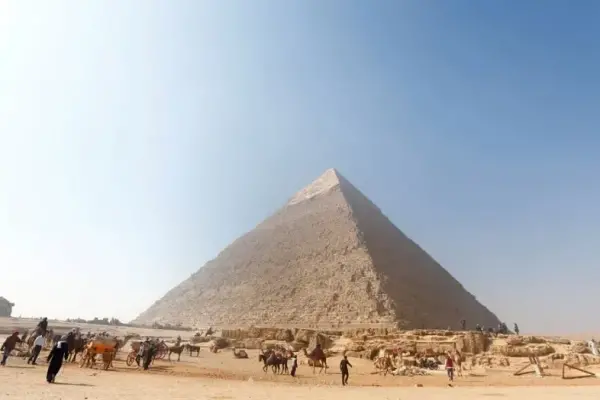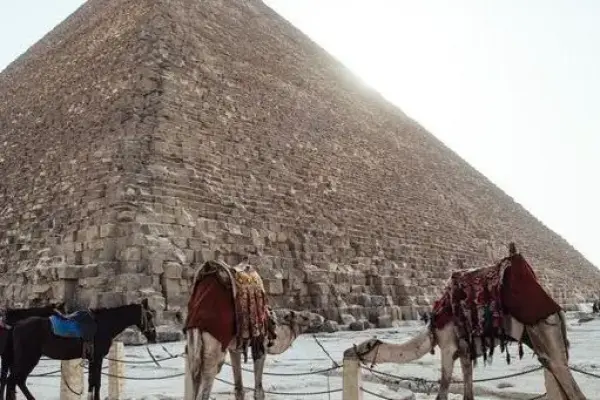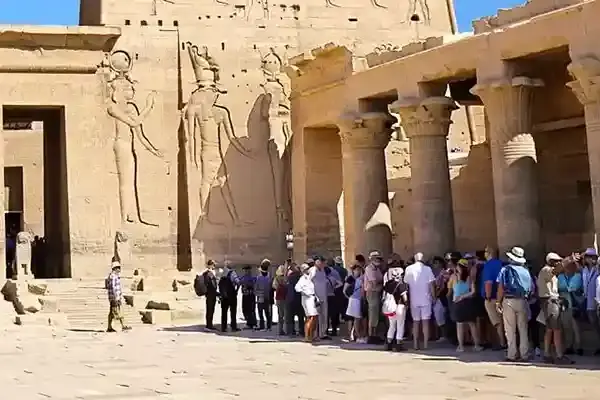How long did it take to build the pyramids- Unveiling the Timeline & Facts

- Feb 06, 2025
- Ancient Egyptian Civilization
- 6,045
The second you spot the exquisite pyramids, the primary query that involves thoughts is: 'How lengthy did it take to construct the pyramids?' This fantastic edifice, one of the Seven Wonders of the Ancient World, has intrigued historians, archaeologists, and curious onlookers for centuries. As you stand earlier than those massive structures, it is tough now no longer to be surprised approximately the enormous attempt in the back of their creation—a feat that mixed masterful engineering, a prepared body of workers of 20,000 to 30,000 professional laborers, and an appropriate placement of about 2. three million stone blocks.
Table of contents [Show]
- When was the Great Pyramid of Giza built
- How long did it take to build the pyramids of Giza
- How many people did it take to build the pyramids
- How many slaves did it take to build the Great Pyramid of Giza
- How many stones did it take to build a pyramid
- Why can not you climb the pyramids anymore?
- Why can't we rebuild the pyramids?
- FAQ
When was the Great Pyramid of Giza built
After reviewing numerous dependable assets, which include historical data and the latest archaeological studies, this is an in-depth answer of our question When was the Great Pyramid of Giza built:
The Great Pyramid of Giza was constructed in the course of the Fourth Dynasty of historic Egypt, kind of among 2580 and 2560 BC
Historical Context:
The Great Pyramid, additionally referred to as the Pyramid of Khufu, was built as a tomb for the Pharaoh Khufu (Cheops). It belongs to the technology referred to as the Old Kingdom of Egypt, that is famous for huge construction projects.
Dating the Construction:
Most scholarly estimates area its production around 2580–2560 BC. This relationship is primarily based totally on an aggregate of archaeological proof, along with inscriptions and data from later periods, in addition to research of the substances and strategies utilized in its production.
Construction Timeline:
While genuine data from the time aren't available, many specialists agree that constructing the Great Pyramid took about two decades. This estimates elements withinside the enterprise of a large, professional hard work pressure and the logistical demanding situations of quarrying, transporting, and assembling tens of thousands and thousands of stone blocks.
See most Strange Facts About The Pyramids .
Archaeological and Historical Sources:
The relationship is supported with the aid of using quite a number of proofs, which include analyses of historical data, architectural research, and the carbon relationship of natural substances discovered in affiliation with the development. Over the years, studies have delicate our knowledge of the timeline, regarding the mid-third millennium BC because of the duration of its production.
Primarily based totally on cutting-edge archaeological consensus, the Great Pyramid of Giza was constructed around 2580–2560 BC, marking one of the maximum fantastic engineering feats of the historic world.
In addition, any other have a look at has found out the opportunity that a department of the Nile River, now no longer in lifestyles today, helped deliver the substances needed to construct the Giza pyramids. This discovery shows that the historic Egyptians might also additionally have used this tributary to facilitate the delivery of stones and heavy substances to the development site.
As for the development duration of the Great Pyramid, it's widely believed that it was constructed over a period of two decades during the Fourth Dynasty of Pharaoh Khufu. However, the thriller surrounding those historic monuments nonetheless remains, commencing the manner for in additional studies and research to decide the precise production duration.
The Egyptian pyramids are a few of the maximum super architectural achievements in historical history, and the info in their production, which includes the duration of time it took to construct, remains a thriller.
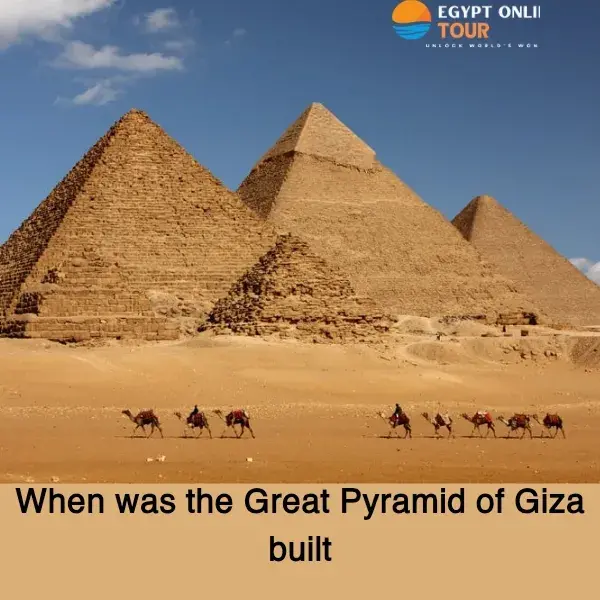
Duration of production of the pyramids:
Historical reassets imply that the development of the pyramids took various quantities of time, relying on the scale and complexity of every pyramid. For example, it's anticipated that the development of the Great Pyramid (Khufu's Pyramid) would take approximately two decades, and in the course of this duration, it's believed that between 2,000 and three,000 employees have been worried withinside the production method, the use of superior equipment and strategies for his or her time.
Read about: Did Thoth Built The Pyramids
Modern theories on production strategies:
In addition to conventional theories that anticipate using ramps and cranes to raise stones, contemporary-day theories have emerged that advocate using progressive strategies:
Hydraulic Theory:
A group of French engineers has counseled that the historic Egyptians used a water-primarily based totally hydraulic machine to raise heavy stones at the same time as constructing the Step Pyramid of Pharaoh Djoser. This idea shows that employees used saved water to raise stone blocks through a hydraulic lift, making the development method easier.
THE TIMES & THE SUNDAY TIMES
This idea is referred to as the "solid stone idea" or "stone concrete idea", and became offered with the aid of the French scientist Joseph Davidovits 5 withinside the 1970s.
Theory Summary:
Davidovits believes that the historic Egyptians no longer carved and delivered massive stones from quarries, however as a substitute used a geological combination of beaten limestone, water, and herbal chemical substances along with natron and clay, which they then poured into timber molds into stone blocks and allowed to dry and harden.
Evidence to guide the idea:
There aren't any conventional reducing and carving marks on a number of the stones withinside the pyramid, indicating that they are no longer transported withinside the conventional manner.
The presence of air bubbles and extraordinary porosity in a few stones, much like what we see in solid substances and now no longer in herbal stones.
Chemical evaluation of a number of the pyramid stones found heterogeneous components, which helps the concept that they may be now no longer totally herbal stones, however, had been the product of a combination of minerals.
The capacity to make massive stones while not having to move them lengthy distances is the reason for the convenience of constructing the pyramid as compared to conventional theories.
Criticisms of this idea:
Some Egyptologists and geologists reject it due to the fact they agree with that chemical evaluation is inadequate to show it, and factor to robust proof that Egyptian employees used conventional stone-shifting strategies.
Excavations have found copper gear and lines of quarries indicating the carving and delivery of stones, now no longer their manufacture.
Books that handled this principle:
"The Pyramids: An Enigma Solved" - Joseph Davidowitz
"Why the Pharaohs Built the Pyramids with Fake Stones" - Joseph Davidovits
"The Secret of the Great Pyramid" - through Jean-Pierre Houdin, any other scientist with a special principle however touching at the concept of forged stones.
The forged stone principle continues to be debatable amongst scientists, however, it gives a thrilling reason behind how the pyramids were constructed without the want to move massive stones from the quarries, which makes it a thrilling present-day principle.
How long did it take to build the pyramids of Giza
The Pyramids of Giza are a few of the maximum distinguished archaeological landmarks withinside the world, and their production took various durations of time, in step with ancient reasserts and present-day research which makes you ask How long did it take to build the pyramids of Giza, here we go the right answer:
Duration of production of the Great Pyramid (Khufu Pyramid):
According to the Greek historian Herodotus, who visited Egypt withinside the 4th century BC, the Great Pyramid took approximately twenty years to construct, even as the development of the passages and decrease components took a further 10 years.
Duration of production of different pyramids:
Khafre's Pyramid: There aren't any correct records of approximately how long it took to construct Khafre's Pyramid, however, it's miles believed that it took a comparable time period to construct the Great Pyramid.
Menkaure's Pyramid: Due to its smaller length as compared to the alternative pyramids, it's miles assumed that its production took a shorter time period, however, there aren't any particular estimates.
Factors affecting the production period:
The Pyramids were most popular during which of the following periods is laid low with numerous factors, inclusive of:
The length and complexity of the pyramid: The larger the pyramid and the greater complicated its design, the longer it takes to construct.
Number of people and strategies used: Increasing the range of people and the use of superior strategies can lessen the development period.
Availability of assets and substances: Easy right of entry to uncooked substances and assets impacts the velocity of production.
While a few reassets imply that the development of the Great Pyramid took approximately twenty years, there may be no correct records approximately the particular term for constructing the alternative pyramids in Giza, as those estimates are primarily based totally on ancient reassets and present-day research, thinking of the different factors that have an effect on the period of production.
Read about: When Was the Great Sphinx Built
How many people did it take to build the pyramids

I accept as true, primarily based totally on the studies, research, and proof to be had to date, that the envisioned numbers of people vary from 20,000 to 100,000, with the latest estimates starting from 20,000 to 30,000, inclusive of craftsmen, engineers, and assist staff.
Modern archaeological studies indicate that the group of workers in the back of the pyramids of Giza—especially the Great Pyramid of Khufu—numbered kind of among 20,000 and 30,000 human beings at its peak. Here's an in-depth breakdown of what is known approximately the exertions pressure and its company:
Seasonal Labor and Specialization:
Evidence suggests that most of the people have been now no longer everlasting slaves but instead seasonal workers. During the once-a-year Nile flood season, while agricultural fields have been underwater, farmers could paint on state-backed projects. This seasonal exertion supplemented a middle of professional craftsmen, engineers, and supervisors who maintained the venture year-round.
Organization and Efficiency:
The group of workers changed into exceedingly prepared specialized crews liable for diverse tasks—which included quarrying the stone, transporting heavy blocks, and assembling the structure. The lifestyles of people's villages and devoted cemeteries on the Giza plateau help the view that those workers have been well-fed, medically attended, and a part of a green, state-prepared gadget. This degree of company could have been crucial to finishing such a good-sized venture in about twenty years.
Revised Estimates Over Time:
Earlier ancient accounts, which include the ones through Herodotus, envisioned that as many as 100,000 people could have been involved. However, present-day archaeological research—supported through proof from excavation sites, employee villages, and logistical analyses—has brought about a downward revision of those figures to the modern consensus of around 20,000–30,000 people.
Applications of the Workforce Size:
The distinctly decreased range as compared to historic estimates no longer lessens the size of the venture; Rather, it highlights the superior planning, aid management, and engineering knowledge of the historic Egyptians. Each employee's contribution changed into a part of a well-coordinated gadget that maximized performance all through the restricted durations while exertions changed into to be had.
Even as the precise range remains a topic of scholarly debate, the triumphing view primarily based totally on the latest proof is that the development of the pyramids of Giza changed into carried out through a well-prepared group of workers of approximately 20,000 to 30,000 human beings, combining seasonal workers with a middle of specialized people. This green exertion gadget changed into one of the keys to the long-lasting legacy of those awesome structures.
Watch the most grateful building in the world via 8 Days Pyramids & The Nile by Air 3
How many slaves did it take to build the Great Pyramid of Giza
In my opinion, the idea of the pyramids being constructed by slaves is inaccurate, as archaeological studies suggest that the development change into accomplished through professional people and employed workers.
I additionally accept as true with that archaeological proof suggests that the Great Pyramid changed into constructed by approximately 20,000 to 30,000 people, the maximum of whom have been loose workers, now no longer slaves.
The concept that the Great Pyramid was constructed by slaves is a lengthy status myth. Modern archaeological studies and research of the people's stays at Giza have supplied a completely special picture:
Skilled Laborers, Not Slaves:
Evidence indicates that the pyramid was built with the aid of a well-prepared staff composed frequently of professional workers and seasonal people as opposed to enslaved individuals. Many of those people had been probable farmers who worked at the venture for the duration of the Nile's flood season whilst their fields had been underwater.
Workforce Size:
Estimates imply that the staff concerned in constructing the Great Pyramid of Khufu numbered kind of among 20,000 and 30,000 human beings at its peak. These people had been prepared into specialized groups liable for quarrying, transporting, and setting the large stone blocks.
Evidence from Workers' Villages:
Excavations at Giza have exposed the stays of people's villages, which encompass proof of respectable residing situations, prepared paintings, or even clinical care. These findings factor into a hard work pressure that becomes valued and supported with the aid of using the state, as opposed to an enslaved populace pressured to paintings below harsh situations.
Cultural and Historical Context:
In historical Egypt, enormous tasks had been frequently state-backed endeavors that hired conscripted hard work for the duration of intervals whilst agricultural paintings were no longer possible. These workers had been compensated in the shape of food, shelter, and different necessities, and they had been afforded a stage of appreciation this is obvious in the care taken of their burials.
There isn't any dependable ancient or archaeological proof to support the concept that the Great Pyramid of Giza was constructed with the aid of slaves. Instead, it seems that a committed staff of about 20,000 to 30,000 loose and professional workers—lots of whom labored seasonally—become liable for this enormous production.

How many stones did it take to build a pyramid
Number of Stones inside the Great Pyramid:
It is extensively expected that the Great Pyramid of Giza be constructed with the use of about 2.3 million stone blocks. However, estimates can also additionally range barely among sources. Here's an in-depth explanation:
Size and Weight of the Stones:
The person stones used inside the pyramid range in weight and length. Most of the blocks weigh between 2. five and fifteen tons, even though a few granite blocks inside the inner chambers can weigh as much as eighty tons. read about: Does Dahshur Pyramids Have Bodies
Calculation Basis:
The estimate of 2. three million blocks comes from the size of the pyramid. The Great Pyramid at the beginning measured approximately 230 meters (755 feet) on every aspect at the bottom and stood about 146 meters (480 feet) tall. Dividing the entire quantity with the aid of using a mean stone blocks quantity consequences inside the typically stated parent.
Maybe like: Is The Sphinx Older Than The Pyramids
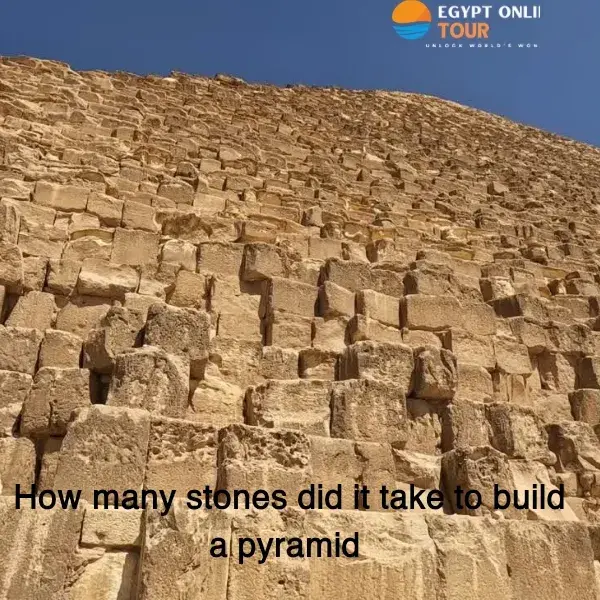
Engineering Considerations:
The production approach concerned exactly cutting, transporting, and setting those blocks with exquisite accuracy. This required now no longer the best state-of-the-art plans and engineering competencies but additionally a distinctly prepared hard work pressure.
Detailed research into the pyramid's production, the use of present-day archaeological strategies, and engineering analysis, assist the parent of about 2. three million stones.
Historical Research:
Early historical historians like Herodotus supplied estimates that had been a lot larger, on occasion claiming loads of hundreds of people and a substantial variety of blocks, however, present-day archaeological studies have delicate those estimates.
Archaeologists have calculated the variety of stones with the aid of assessing the pyramid's quantity (approximately 2.6 million cubic meters) and dividing with the aid of using the common quantity of the person's stones.
Variations in Estimates:
Different research can also additionally offer barely specific numbers, typically starting from 2 to 2. to five million stones, relying on assumptions approximately the sizes of numerous sections of the pyramid (inclusive of the internal chambers as opposed to the outer casing).
Distinctive research and archaeological studies endorse that it took kind of 2. three million stone blocks to construct the Great Pyramid of Giza. This estimate is derived from calculations primarily based totally on the pyramid's dimensions and the everyday length of the stone blocks used, supported with the aid of present-day engineering and archaeological analysis.
Why can not you climb the pyramids anymore?
I see that the Egyptian authorities have currently banned hiking at the pyramids to guard them from erosion and damage, further to cultural and historical issues.
The pyramids, in particular the ones at Giza, are not open to hiking for numerous critical reasons, all of which are consciousness of safety, upkeep, and appreciation for the cultural historical past. Here's an in-depth take a observing the elements at the back of the ban:
Preservation of the Monuments:
The pyramids are historical systems that have stood for hundreds of years of history. Climbing on them can cause bodily put on and tear at the sensitive limestone casing and the underlying core. Each step or scratch can also additionally appear minor, however over time, those influences accumulate, contributing to irreversible damage. Conservation professionals and historical past governments emphasize that even moderate deterioration may compromise the integrity of those valuable monuments.
Safety Concerns:
Climbing the pyramids poses massive dangers to site visitors. The surfaces are uneven, and there are steep inclines with minimum handholds, making falls or accidents probable. In addition, the intense climate situations in Egypt—excessive warmth for the duration of the day and on occasion surprising climate changes—can exacerbate the dangers. To save you from injuries and capacity lack of life, the government has confined admission to to regions that would be hazardous.
Protection of Cultural Heritage:
The pyramids aren't simply historical systems; They are crucial to Egypt's cultural identification and history. Allowing unrestricted hiking can result in vandalism or unintended damage to inscriptions, reliefs, or different info that offer perception into the lives and ideals of the historical Egyptians. Protecting those cultural treasures is a priority, and restricting bodily get admission to is one of the measures taken to ensure their upkeep for destiny generations.
Tourism Management:
As visitor destinations, the pyramids appeal to tens of thousands and thousands of site visitors every year. Managing such big numbers in a manner that minimizes the effect on the systems has turned out to be a chief concern. The ban on hiking allows the go with drift of travelers and decreases the chance of overcrowding at the historical sites, thereby assisting in controlling the general effect on the surroundings and the monuments themselves.
Legal and Regulatory Measures:
Egyptian authorities, at the side of worldwide background organizations, have applied strict guidelines concerning what site visitors can and can not do at those webweb sites. The mountaineering ban is enforced via way of means of law, and violators might also additionally face fines or different penalties. This prison framework is part of a broader attempt to stabilize tourism with the long-term renovation of Egypt's historical monuments.
The prohibition on mountaineering the pyramids of Giza is the end result of a well-taken-into-consideration technique to protect those historical wonders. It displays a dedication to maintaining the structural integrity of the pyramids, ensuring the protection of site visitors, safeguarding cultural background, coping with the effect of tourism, and adhering to mounted prison standards. While mountaineering as soon as furnished a completely unique angle on those enormous structures, present-day conservation, and protection necessities now require that site visitors admire the pyramids from detailed viewing regions that limit harm and risk.
Read about: What countries have pyramids

Why can't we rebuild the pyramids?
Now, with all the modern techniques that we have, we all ask why can't we rebuild the pyramids.
I suppose rebuilding the pyramids faces main challenges, together with the lack of authentic materials, the quantity of historical generation, and the cultural effect.
Rebuilding the pyramids—whether or not to copy them precisely or to assemble new monuments of their likeness—is an concept that has intrigued many. However, there are numerous sizeable motives why this isn't always done:
Historical and Cultural Authenticity:
The authentic pyramids are irreplaceable symbols of historical Egyptian civilization. They convey historic, cultural, and archaeological importance that can not be replicated. Rebuilding them could erase the authenticity of the authentic monuments, which function tangible hyperlinks to human history.
Original Construction Techniques and Materials:
The historical developers used strategies and domestically sourced materials (along with particular styles of limestone and granite) which are frequently now no longer to be had inside the identical shape or quality. Modern production strategies fluctuate significantly from the ones of antiquity, and at the same time as we will mimic the appearance, the method of constructing them could now no longer mirror the ingenuity and craftsmanship of the historical Egyptians.
Engineering Challenges and Labor:
The pyramids have been built over many years with a tremendous team of workers the use of gear and strategies that have been labor-extensive and time-consuming. Recreating the sort of task today—mainly at an identical scale—could require large logistical and engineering efforts, and it might probably be impractical given modern financial and technological priorities.
Legal and Ethical Considerations:
The authentic pyramids are UNESCO World Heritage Sites and are covered by worldwide law. Any try to rebuild or notably modify the web websites could face widespread prison, ethical, and conservation challenges. Preserving the integrity of those historical monuments is worldwide precedence, and present-day interventions that would compromise their country are strongly discouraged.
Economic and Practical Priorities:
The resources required—time, money, and human attempt—to rebuild the pyramids could be astronomical. Many professionals and policymakers argue that it's miles neither economically sensible nor proper to dedicate such sources to a task that duplicates an already current cultural treasure.
Purpose and Legacy:
The pyramids have been constructed as tombs and monuments with non secular and cultural importance, reflecting the values and ideals of their time. A present-day reconstruction could lack the historical context and religious which means imbued via way of means of centuries of tradition, discovery, and scholarship. Their legacy as historical wonders is a part of what makes them so charming and treasured by humanity.
At the same time as the present-day generation would possibly permit us to assemble a shape that appears much like the pyramids, doing so could overlook the profound historical, cultural, and technical contexts that make the authentic pyramids unique. Preserving and analyzing those historical monuments remains a better precedence than trying to recreate them.
Try the best magic journey with the Egypt online tour 12 Days Pyramids, Nile & Sinai Tour

Conclusion
The Great Pyramid of Giza continues to captivate the arena with its amazing timeline and engineering marvel. Built around 2580–2560 BC, its production spanned more or less 20 years, a feat accomplished via way of means of a well-prepared team of workers of 20,000 to 30,000 professional laborers—now no longer slaves. Approximately 2. three million stone blocks have been meticulously positioned to shape this enormous shape. Today, present-day conservation efforts make sure that site visitors recognize the pyramids from a secure distance, as mountaineering is against the law to maintain their integrity. Likewise, the concept of rebuilding those historical wonders is brushed off because of the cultural, historical, and engineering importance that can not be replicated. This article has explored the iconic mysteries of production duration, a team of workers organization, fabric usage, and present-day renovation practices, losing mild on how one in all history's finest achievements stays an undying testimony to human ingenuity and civilization.
FAQ
How do we know it took 20 years to build the pyramids?
The evidence primarily comes from historical accounts and modern archaeological analysis. For instance, the Greek historian Herodotus, writing in the fifth century BCE, recorded that his Egyptian guides claimed 100,000 men worked for three months each year over a span of twenty years to construct the Great Pyramid. Recent studies, including logistical models and worker village excavations, support a similar timeframe, emphasizing the efficiency of seasonal labor during the Nile's flood season. Additionally, inscriptions and administrative records from ancient Egypt further corroborate these estimates, highlighting a well-organized state project.
Who built the pyramids?
It was the ancient Egyptians who built the pyramids, with the Great Pyramid of Khufu dating back roughly 4,600 years to his reign during the Fourth Dynasty. This monumental achievement was the result of a highly skilled and organized workforce comprised mainly of free laborers and seasonal workers, not slaves. Moreover, the pyramids—over 100 in Egypt—served as royal tombs and were constructed using advanced engineering techniques that reflected the Egyptians' deep understanding of mathematics and astronomy.
How long did it take to build the Sphinx?
Estimates suggest that constructing the Great Sphinx took about three years, with around 100 workers employing stone hammers and copper chisels to carve the limestone statue. Most scholars date the Sphinx to the Fourth Dynasty, attributing it to the reign of Pharaoh Khafre, who is believed to have commissioned the work. Recent geological and erosion studies have also provided insights into the Sphinx's age and construction techniques, further underlining the remarkable ingenuity and precision of ancient Egyptian artisans.
Popular Categories
Popular Posts

Top Alexandria Beaches You Must Visit 2026

What are the important holidays in Egypt?
